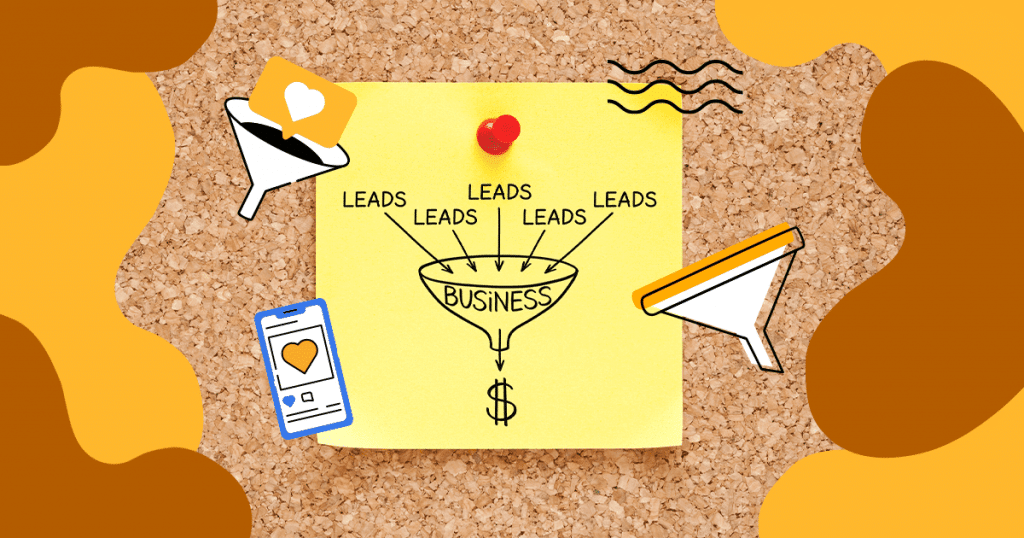There are countless ways in which you can market your company online, especially when it comes to social media.
However, no social media marketing strategy quite compares to the social media marketing funnel.
After all, people tend to spend roughly 2 hours and 30 minutes on social media every day.
Therefore, if you aren’t maximizing the use of social media in your marketing funnel, chances are you’re missing out on a lot of leads and conversions.
Want to learn more? Here’s what we’ll cover in this blog post:
What Is a Social Media Marketing Funnel?
In order to understand what a social media marketing funnel is, you need to first understand what a marketing funnel is.
A basic marketing funnel is ultimately the journey of a potential customer from the time the prospect becomes familiar with your brand to the time they make a purchase with your company — and even afterward.
In even simpler terms, a marketing funnel ultimately follows the steps of an individual as they move towards becoming an actual customer.
At every stage of the marketing funnel, you will have the chance to utilize multiple techniques and tactics to influence the prospect’s behavior to steer them in the direction you wish for them to go.
A social media marketing funnel simply brings social media into the picture. Ultimately, this funnel begins with social media, although it is often used throughout the entire funnel.
The social media marketing funnel ideally ends when the customer becomes a brand ambassador.
This means that the customer will represent and spread the word about your company in a positive light.
Stages of the Social Media Marketing Funnel
There are five main stages to the social media marketing funnel. These stages may vary from one business to the next.
However, regardless of how you choose to construct your funnel, the journey of the customer will follow a basic pattern that will end up leading to a purchase, satisfied customers, and long-term advocacy for your overall brand.
Now, when it comes to the stages of the social media marketing funnel, it’s imperative to remember that each of the five stages is interconnected with one another, as the prospect will move from one stage to the next all the way to the end of the marketing funnel.
The idea of the entire funnel is to slowly introduce your products and services to the prospect as a solution to a problem they are having, which was presented at the beginning of the funnel.
Awareness Stage
The customer journey begins at the awareness stage, which is at the very top of the social media marketing funnel.
At the stage of awareness, a prospect who had no previous knowledge of your company or brand notices that your business exists.
They become familiar with your products/services and what problems you may be able to solve.
At this point, the prospect may not even realize that they have a problem that needs solving, but it is your job to make them realize they have one and how your brand can help them solve it.
Keep in mind you won’t be pitching your product or service to the prospect. Instead, you are simply establishing your brand in the back of their mind so that they’re able to quickly recall it in the future.
During the awareness stage, some of the best types of content that you will want to feature include short video tutorials, blog posts, YouTube videos, giveaways, infographics, and social media ads.
Consideration Stage
The next stage in the social media marketing funnel is called the consideration stage. This is where the prospect is researching what you have to offer and comparing it to your competition.
At this point in the buyer’s journey, they are well aware of their problem and looking for a solution.
However, they are not truly ready to commit to anything or any company yet. That’s where the comparison comes in.
Some factors that will play a role in where the prospect ends up landing include features, price, customer service, and reviews.
Your job during the consideration stage is to convince the prospect that you have a better overall product or service.
Some tactics you will want to use during this stage include Facebook Groups, LinkedIn Groups, IGTV, Twitter Chats, YouTube videos, forum posts and comments, product demos, and social media ads.
Content that you produce should focus on your products or services and their features. You will be showcasing why your offerings are the best of the best.
Some types of content to consider include product reviews, testimonials, case studies, infographics, blogs, white papers, and webinars.
You can use social media to help encourage downloads and registrations. Consider offering a 30-day free trial of your product, depending on what you are offering.
Action Stage
The middle of the funnel is considered the action stage, or the conversion stage.
During this stage of the social media marketing funnel, the prospect makes the decision to purchase from your brand and completes a sale.
Some of the most important factors during this stage of the funnel include customer reviews, case studies, social proof, and product demos. Remarketing and retargeting can be key as well.
Some tactics that may give your prospects the nudge they need to make a purchase include contests on social media with incentives for purchase (think a small new customer discount or free shipping), advertisements on social media with timed coupons/offers, and social media contests with promotions.
Make sure that you are listening to feedback from customers so you know what hesitations prospects may have that could be keeping them from making purchases at this stage of the funnel.
This feedback can help you improve and convert prospects in the future.
Engagement Stage
The fourth stage of the social media marketing funnel is the engagement stage.
During this stage, you want to ensure the buyer feels 100 percent supported so they don’t feel any form of buyer’s remorse.
Once a customer purchases a product, many companies tend to forget about the customer and never think about them again.
Unfortunately, this can limit the chance of customer loyalty and repeat purchases.
Your goal during this stage is to build engagement within your online community of customers. You want to reassure your customer about their recent purchase and give them the opportunity to share their experience about your product/service and brand.
Branded hashtags go over well on social media if you have a visual product that can be shared.
Alternatively, you can use Twitter chats and LinkedIn to garner a sense of community that helps the buyer feel wanted and heard.
You could consider going live on Facebook every week to answer customer questions.
A Facebook group can also be created solely for your customers as a place for them to connect with one another and talk about your services and products.
Advocacy Stage
The final stage of the funnel is the advocacy stage. The goal of this stage is to help turn your customers into brand ambassadors.
When a customer is happy with your product/service, it shines through in their voice (or words). If they trust your brand, they can ensure their friends, family, and other followers also trust you.
At this point of the social media marketing funnel, you want to collect product/service reviews and customer testimonials. Facebook now hosts reviews, and testimonials can easily be shared via short videos.
Some tactics you can use during this stage to increase loyalty among buyers and increase the chances of advocacy are incentives like giveaways, a loyalty rewards program, and customer referrals.
In fact, some customers look for and need incentives after their initial purchase to keep coming back and being willing to spread the word about your company and brand.
What Do You Need to Know Before Creating This Funnel?
One of the biggest mistakes often made with social media marketing funnels is failing to invest in all five stages of the funnel.
Each stage is in place for a reason, and without all of them being used together, it could impact the overall success of the marketing campaign.
When you only move forward with a few of the stages of the funnel, a potential buyer can often tell due to the fact that your content is too salesy. As such, it can impact the prospect’s ability to build trust with your brand.
In the end, there is a higher chance of prospects converting and making a purchase.
If the reasoning behind wanting to focus on two or three stages of the funnel is limited resources or financial constraints, then simply limit your focus to only a couple of tactics within each stage.
You don’t have to go all-out with the content and tactics.
So, invest in the social media marketing funnel as a whole so you can build a loyal group of customers that will help build your brand.
How to Build the Best Social Media Marketing Funnel?
Follow our tips to reach the best results in your business.
Tip #1: Establish Your Goals
Prior to starting your social media marketing funnel, you must determine what you are expecting to gain out of it.
When establishing your goals, try to be as specific as possible, as this will help you identify whether you were successful later on.
For instance, your goal should be more than to gain more subscribers to your e-mail list.
Instead, you should identify the number of subscribers you hope to gain out of, the type of subscribers, the number of subscribers you want to convert into customers, and more.
Tip #2: Craft Your Lead Magnet
The lead magnet is defined as something of value that can be offered to prospects for free. It is ultimately something attractive that draws them in.
Some examples of content may be articles, infographics, newsletters, and video.
The key is to ensure you include a call to action, which drives them to a signup form of some kind. The goal here is to obtain their contact information to use at a later date.
Tip #3: Develop Your Offers
In order to get prospects to move smoothly from one stage in the funnel to the next, you need enticing offers to extend to them.
These offers should persuade them to make a small level of commitment that ultimately ends with a sale.
Some examples include downloading a guide or ebook, signing up for a newsletter, booking a free consultation, watching a product demonstration, and the like.
Tip #4: Optimize Your Landing Page
It is imperative that your landing page is optimized and is where prospects land after they leave social media.
They don’t want to land on your homepage. Otherwise, your warm lead may turn cold very quickly and the buyer’s journey ends right then and there.
You should design specialized landing pages for where prospects will be taken that have a defined goal and offer. This will help increase the chances of a conversion.
Tip #5: Track the Metrics and Be Ready to Tweak
Marketing is all about the data. To determine what will work best, you should have A/B ads and landing pages that you test.
This takes a lot of the guesswork out of what performs and converts for you.
You will also want to measure a variety of metrics on social media.
For instance, take a close look at awareness and engagement metrics, such as likes, comments, shares, pins, post reach, @ mentions, impressions, and video views.
Don’t forget to also pay attention to metrics related to conversions like cost-per-click, click-through-rate, and actual conversion rate.
If you notice something isn’t working well or as well as you would like, tweak it and see if it works better. You may find that your audience prefers funny posts as opposed to news-related posts.
Test to determine when the best time of day and week is to post on your social media platform (and keep in mind each platform will be different) to get the most engagement from your audience.
Remember your social media success lies in the data, so don’t overlook it!
Wrap Up: Social Media Is Key to the Buyer’s Journey and Brand Awareness
Social media has proven its effectiveness at increasing brand awareness, so it makes sense that it can play a significant role in the buyer’s journey.
It is up to you, though, to ensure that each stage of the funnel is touched upon to ensure the prospect moves along smoothly towards a conversion.
And, with social media included in the funnel, buyers have a better chance at developing a deeper connection with your brand.
To help increase the effectiveness of your social media marketing funnel, you will want to start with a solid social media strategy.
Learn more about what social media strategy is and how to build one!



![[ROCK NA] [EBOOK SEO] Complete Guide](https://rockcontent.com/wp-content/uploads/2024/06/banner_Search-Engine-Optimization.png)






